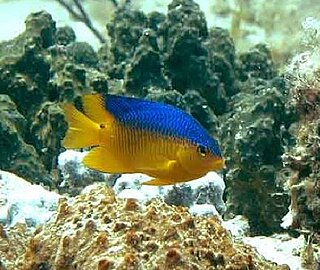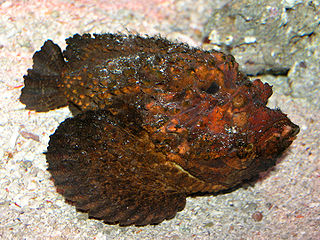
The Percidae are a family of ray-finned fish, part of the order Perciformes, which are found in fresh and brackish waters of the Northern Hemisphere. The majority are Nearctic, but there are also Palearctic species. The family contains more than 200 species in 11 genera. The perches and their relatives are in this family; well-known species include the walleye, sauger, ruffe, and three species of perch. However, small fish known as darters are also a part of this family.

Pomacentridae is a family of ray-finned fish, comprising the damselfishes and clownfishes. This family were formerly placed in the order Perciformes but are now regarded as being incertae sedis in the subseries Ovalentaria in the clade Percomorpha. They are primarily marine, while a few species inhabit freshwater and brackish environments. They are noted for their hardy constitutions and territoriality. Many are brightly colored, so they are popular in aquaria.

Synanceiinae is a subfamily of venomous ray-finned fishes, waspfishes, which is classified as part of the family Scorpaenidae, the scorpionfishes and their relatives. These fishes are found in the Indo-Pacific oceans. They are primarily marine, though some species are known to live in fresh or brackish waters. The various species of this family are known informally as stonefish, stinger, stingfish and ghouls. Its species are known to have the most potent neurotoxins of all the fish venoms, secreted from glands at the base of their needle-like dorsal fin spines. The vernacular name, stonefish, for some of these fishes derives from their behaviour of camouflaging as rocks. The type species of the family is the reef stonefish.

Hexagrammidae, the greenlings, is a family of marine ray-finned fishes belonging to the suborder Cottoidei in the order Perciformes. These fishes are found in the North Pacific Ocean.

Stichaeidae, the pricklebacks or shannies, are a family of marine ray-finned fishes in the suborder Zoarcoidei of the order Scorpaeniformes. Most species are found in the North Pacific Ocean with a few in the North Atlantic Ocean.

Setarchinae, the deep-sea bristly scorpionfishes, is a small subfamily of deep-sea ray-finned fishes, it is part of the family Scorpaenidae. They are small marine fishes, growing up to 25 cm, and are found in tropical and subtropical waters throughout the world.

Stegastes nigricans, the dusky farmerfish, is a species of damselfish found around coral reefs at a depth of one to 12 meters, in tropical climates between 30°S and 30°N. They are known for farming monocultures of algae such as cyanophores and rhodophytes.
Bahaba is a genus of marine ray-finned fishes belonging to the family Sciaenidae, the drums and croakers. These fishes are found in the Indo-West Pacific region.

The leaf goblinfish is a species of marine ray-finned fish, a waspfish belonging to the subfamily Tetraroginae, which is classified as part of the family Scorpaenidae, the scorpionfishes and their relatives. This is the only species in the monotypic genus Neovespicula. It is found in coastal habitats of the Indo-West Pacific region.

Caesionidae, the fusiliers, are a family of marine ray-finned fishes in the order Perciformes. The family includes about 23 species. They are related to the snappers, but adapted for feeding on plankton, rather than on larger prey. They are found at reefs in the Indo-Pacific and in the Red Sea.

Tetraroginae is a subfamily of marine ray-finned fishes, commonly known as waspfishes or sailback scorpionfishes, belonging to the family Scorpaenidae, the scorpionfishes and their relatives. These fishes are native to the Indian Ocean and the West Pacific. As their name suggests, waspfishes are often venomous; having poison glands on their spines. They are bottom-dwelling fish, living at depths to 300 metres (980 ft). These creatures usually live in hiding places on the sea bottom.

Larimichthys is a genus of marine ray-finned fishes belonging to the family Sciaenidae, the drums and croakers. These fishes, commonly known as yellow croakers, are found in the Western Pacific Ocean.

Centropogon is a genus of ray-finned fishes, waspfishes belonging to the subfamily Tetraroginae, which is classified as part of the family Scorpaenidae, the scorpionfishes and their relatives. These fishes are endemic to the brackish and marine waters around Australia.

Ablabys is a genus of marine ray-finned fishes, waspfishes belonging to the subfamily Tetraroginae, which is classified as part of the family Scorpaenidae, the scorpionfishes and their relatives. The fishes in this genus are found in the Indian Ocean and the western Pacific Ocean.

The marbled spinefish, also known as the yellow waspfish, is a species of ray-finned fish, a waspfish belonging to the subfamily Tetraroginae of the family Scorpaenidae, the scorpionfishes and their relatives. It is the only species in the monotypic genus Cottapistus. This species is found in the Indo-West Pacific.

Vespicula is a genus of venomous ray-finned fishes, waspfishes belonging to the subfamily Tetraroginae, which is classified as part of the family Scorpaenidae, the scorpionfishes and their relatives. These fishes are native to the Indian Ocean and the western Pacific Ocean. Although FishBase recognises this genus as valid, other authorities, such as the Catalog of Fishes regard it as a synonym of Trichosomus.

Acanthocepola is a genus of marine ray-finned fishes belonging to the family Cepolidae, the bandfishes. They are native to the Indian Ocean and the western Pacific Ocean.

Pomacentrinae is one of four subfamilies in the family Pomacentridae which includes the clownfishes and the damselfishes. It is the most diverse of the subfamilies in the Pomacentridae with around 21 genera and approximately 200 species.
Eulophiidae, the spinous eelpouts, is a small family of marine ray-finned fishes classified within the suborder Zoarcoidei of the order Scorpaeniformes. They are found in the northwestern Pacific Ocean.

Evynnis is a genus of marine ray-finned fishes belonging to the family Sparidae, which includes the seabreams and porgies. The genus comprises 4 species, 3 in the Western Pacific Ocean and 1 in the Eastern Atlantic Ocean.






















